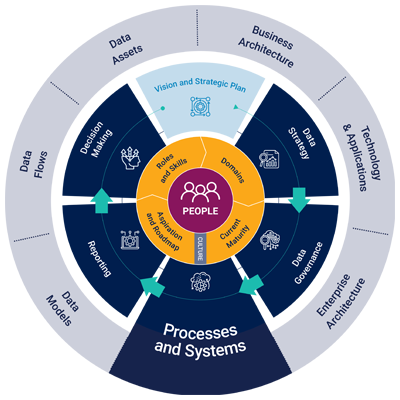Processes and systems
The role of processes and systems to generate reports and performance metrics within the data maturity framework.
Who owns processes and systems?

The director or head of IT has overall responsibility for the provision and support of corporate systems delivered by:
- information technology
- head of management information systems
- business system leads and administrators
The processes that define how systems are configured and used are typically managed by the IT function based on requirements from the relevant area of the organisation. Responsibility for definitions in specific systems may lie with individuals within department or professional services teams.
In larger organisations, there may also be specialist roles to undertake the strategic development of the system and process landscape:
- enterprise architect
- data architect
- business architect
The role of processes and systems
Systems generate and hold institutional and college data, based on agreed processes. This data is directly used to create live, near live and trend reporting. It is also used to create statutory and regulatory reporting which may be returned in the form of sector wide reports and datasets or used to generate performance metrics.
Systems hold different types of data. Transactional data refers to the information added by users undertaking administrative activity – for example, a student registration date and status. Systems also hold master and reference data, typically maintained by IT in consultation with other departments, and meta data, some of which is generated automatically by systems as new information is added:
- Master data ensures core factual information is recorded consistently, eg course code, course title.
- Reference data enables defined classification, eg subject hierarchy, demographic categories.
- Meta data identifies when changes took place, eg timestamps.
Processes, systems and data maturity
Mature institutions and colleges are likely to use defined processes to record activities in standard systems, flexible enough to reflect multiple scenarios. New systems are implemented within a managed architecture with clarity on dependencies and automated migration. Master and reference data is owned and updated, and all data types and fields are defined and understood.
Where institutions and colleges are less mature, systems do not reflect the processes used to run the organisation. Processes may be ill defined or frequently evolving, system development falls behind business innovation, and IT specialists lack visibility of requirements. Siloed or localised solutions proliferate to manage administration. If the source of good quality data is compromised, all further elements of data maturity become dependent on workarounds and manual interventions, frequently unseen by the wider business. This is a particular risk in relation to statutory delivery. Challenges with source system data – or “rubbish in, rubbish out” - are one of the biggest blockers to effective reporting and statutory compliance.
Processes and systems themes
We have divided processes and systems into the following six thematic areas.
Business architecture
The relationship between the "business" - university, college or provider - and its data.
Data assets
The consistent standards and data definitions that support a unified data landscape.
Data flows
How information is added to systems and how data flows between them.
Data models
The delivery of good governance - how data is managed well and documented effectively.
Enterprise architecture
The benefits of enterprise architecture on effective data management.
Technology and applications
The systems that hold your data.
Reporting
The production and delivery of reporting falls within the remit of the chief data officer.
The data maturity framework is copyright Jisc and made available under CC BY-NC-ND. Find out more about using content from the data maturity framework.